Ad
Performance in Spark 2.0, PDX Spark Meetup 8/18/16
- 3. Copyright © 2016, Oracle and/or its affiliates. All rights reserved. | About me Sr. Director Strategic Applica0ons Engineering, Oracle Systems Group • Oracle Hardware Systems Performance & benchmarks: x86 & SPARC products • 30 years parallel programming, performance opImizaIon & benchmarks: aNached processors, Hypercube, MPPs, SMPs, NUMA… • FloaIng Point Systems, Cray, Sun, Oracle • Skier • Traveler • Big Wall Climber • I Drive an Art Car 3
- 4. Copyright © 2016, Oracle and/or its affiliates. All rights reserved. | Spark is ExciIng – But You Already Know That! Spark’s Whole Ecosystem totally appeals to the performance expert in me ! • Great Ecosystem for AnalyIcs – Spark forms a conInuum with other technologies (Kaaa, Solr, …) • Spark is fast & scalable because of clean design – Spark’s in-memory focus • Spark speaks SQL & DataFrames – Perfect marriage for Data ScienIsts & Hardware AcceleraIon – Oracle’s Sofware in Silicon can be used on Apache Spark • Lots of Oracle customers using Apache Spark 4
- 5. Copyright © 2016, Oracle and/or its affiliates. All rights reserved. | Apache Spark 5 Spark Core (Implemented in Scala & JVM, operates on RDDs) Spark SQL (SQL & DSL(Scala/Java/Python…) Spark API: Scala, Python, R, Java DataFrames / DataSets Data Sources: Json, csv, Hadoop, Cassandra, Hive, Hbase, Postgres, MySQL, Elasticsearch,... Spark Streaming (Streaming Analytics micro-batches) Spark MLlib (Machine Learning & statistic routines) GraphX (Graph)
- 6. Copyright © 2016, Oracle and/or its affiliates. All rights reserved. | Apache Spark 2.0.0 Great New Features • Spark SQL – SQL 2003 and Unified DataFrames/Datasets API. – Tungsten Phase2: Whole Stage CodeGen • Spark Mllib & GraphX – Large Scale Machine Learning on Apache Spark • Structured Streaming 6 Best new features - Star0ng with Spark SQL
- 9. Copyright © 2016, Oracle and/or its affiliates. All rights reserved. | SQL is Powerful Feature of Apache Spark • SQL is a powerful language for the wide range of Data ScienIsts – Expresses set operaIons on data of any size: sort , filter, manipulate etc • SQL concisely express data manipulaIon at scale in readable way – ETL (Extract, Transform, and Load) – Feature selecIon for ML – Feature creaIon/generaIon for ML – Report generaIon • Many well-known techniques to efficiently opImize SQL – Apache Spark “Catalyst opImizer” reorganizes query for fastest execuIon – Extensible: you can contribute your own opImizaIons 9
- 10. Copyright © 2016, Oracle and/or its affiliates. All rights reserved. | Spark SQL & DataFrames: Perfect for Data ScienIsts Amazing work which also efficiently puts Data In Memory for fast access • SQL easiest way to write code to filter, merge, scan, … – scala> dfr =sparkSession.sql("SELECT firstName, age, gender FROM cust WHERE age > 20 ORDER BY age DESC").show() • DataFrames columnar and typed // schema: firstName:String, lastName:String, gender:String, age:Int – DataFrames beNer for analyIcs than generic RDDs 10 RDD: row-based, original Apache Spark data structure Jay,Lock,M,81 Rosa,Ruiz,F,14 Clair,Bride,F,23 DataFrame: columnar Jay Lock M 81 Rosa Ruiz F 14 Clair Bride F 23
- 11. Copyright © 2016, Oracle and/or its affiliates. All rights reserved. | Columns: what is in them? Why not just row-store? • Each customer data point, event, etc. has many kinds of possible data • Spark Schema’s defines the columns and their types, can have huge numbers 10’s to 100’s (very wide columns) 11 Different characteris0cs of a data point are stored in different columns Name Addr St City Zip Age Id’ed Gender Edu Sal Marital Loyalty plan Cust Year Buy Freq Fav Devices Com mode … Duma 6 nw 7 Or PDX 97223 25 F MA 60k M Lev2b 5.7 .2 iPh txt val loSchema = StructType( StructField("lo_orderkey", IntegerType, true) :: StructField("lo_linenumber", IntegerType, true) :: StructField("lo_custkey", IntegerType, true) :: StructField("lo_partkey", IntegerType, true) :: StructField("lo_suppkey", IntegerType, true) :: StructField("lo_orderdate", StringType, true) :: StructField("lo_orderpriority", StringType, true) :: StructField("lo_shippriority", StringType, true) :: StructField("lo_quanIty", IntegerType, true) :: StructField("lo_extprice", IntegerType, true) :: StructField("lo_ordtotalprice", IntegerType, true) :: StructField("lo_discount", IntegerType, true) :: StructField("lo_revenue", IntegerType, true) :: StructField("lo_supplycost", IntegerType, true) :: StructField("lo_tax", IntegerType, true) :: StructField("lo_commitdate", IntegerType, true) :: StructField("lo_shipmode", StringType, true) :: StructField("lo_ordermode", StringType, true) :: StructField("lo_webIme", FloatType, true) :: StructField("lo_shopcarvme", FloatType, true) :: . . . StructField("lo_loyaltyPercnt", FloatType, true) :: Nil) An analysis may only need to explore a small subset of these columns. Much faster if only access the needed column, also many server benefits!
- 12. Copyright © 2016, Oracle and/or its affiliates. All rights reserved. | OLD case class Customer (c_custkey: Int, c_name: String, c_address: String, c_city: String, c_phone: String, c_mktsegment: String) ... object RCDBTestProgram { def main(args: Array[String]) { val sparkConf = newSparkConf() .setAppName("RCDB") val sc = new SparkContext(sparkConf) val sqlContext = new org.apache.spark.sql.SQLContext(sc) ... val dataDir ="file:/Users/bc/datasets/R_SF1000/” val df1 = sc.textFile(dataDir+”customer.csv") .map(_.split(";")) .map(p => Customer(p(0).trim.toInt,p(1), .trim,p(2).trim,p(3) .trim,p(4).trim,p(5).trim,p(6).trim)) .toDF() df1.registerTempTable(”customer”) ... query = "””SELECT COUNT(*) FROM customer""” val count = sqlContext.sql(query).take(1) New object RCDBTestProgram { def main(args: Array[String]) { val sparkSession = SparkSession.builder .appName("RCDB”).getOrCreate() ... val dataDir ="file:///Users/bc/datasets/R_SF1000/” val custSchema = StructType( StructField("c_custkey", IntegerType, true) :: StructField("c_name", StringType, true) :: StructField("c_address", StringType, true) :: StructField("c_city", StringType, true) :: StructField("c_phone", StringType, true) :: StructField("c_mktsegment", StringType, true) :: Nil) val df3 = sparkSession.read.option("sep", ";") .option("header","false").schema(custSchema) .csv(dataDir+"customer.csv").toDF().repartition(256) df3.createOrReplaceTempView("customer") df3.persist(StorageLevel.OFF_HEAP) ... query = "””SELECT COUNT(*) FROM customer""” val count = sparkSession.sql(query).take(1) ... sparkSession.sql("SHOW TABLES").show() sparkSession.catalog.listTables.show() 12 Apache Spark 2.0.0 New SparkSession replacing the SQLContext https://databricks.com/blog/2016/08/15/how-to-use-sparksession-in-apache-spark-2-0.html
- 16. Copyright © 2016, Oracle and/or its affiliates. All rights reserved. | Spark 2.0: A big performance Increase with Tungsten Phase2 SELECT count(*) FROM lineorder WHERE lo_quan0ty BETWEEN 10 and 20 1. Volcano Iterator model: SQL plan interpretaIon – Open; – Next data element; – perform predicate; – Close – …Iterate 2. “College Freshman” Java code: Tungsten Whole Stage codeGen pipelined code – for (lo_quan$ty in lineorder { – if (lo_quan$ty > 10 and lo_quan$ty < 20) – { count += 1} – } 16
- 18. Copyright © 2016, Oracle and/or its affiliates. All rights reserved. | The Basic AnalyIcs Flow A lot of 0me spent in Data Munging • Data can come from many sources – Databases, NoSQL, csv, feeds… • We need to prepare it – Data Munging of all sorts! • Analyze the data – Find the “right way” to analyze it • ML, Graph, SQL… 18 Databases Data Munging RESULTS Analy0cs NoSQL, Search. … Streaming Kafa, Storm…
- 19. Copyright © 2016, Oracle and/or its affiliates. All rights reserved. | ConInuous AnalyIcs Cycle Results Ofen Enrich TransacIons Analy0cs is more than one pipeline stream • ConInuous iteraIons around the data analyIcs wheel – Save, catalog, and re-use all things: data, SQL, code, and analyIcs • In-memory advantages at each stage – SPARC’s DAX & leading bandwidth is key • Many sources of data – Internal proprietary, public data, external streaming, archives 19 Streaming Kafa, Storm, … Enhance TransacQons Reports Databases NoSQL ETL (SQL) ETL (SQL) In-Memory ML & Graph (FP) Result Delivery (SQL) Feature Extract, Generate & Transform (SQL) All modern Apps (Uber, Neolix, Amazon, FB …) enhancing transac$ons with Real-$me analy$cs Ad Hoc
- 20. Copyright © 2016, Oracle and/or its affiliates. All rights reserved. | SQL sqlContext.udf.register("newTitle", Itles.getOrElse((_: String),"Other")) sqlContext.udf.register("toString", (_: Int).toString) val avgAge = dataDFRaw.select("Age”).agg(avg("Age")).first().getDouble(0) val avgFare = dataDFRaw.select("Fare”).agg(avg("Fare")).first().getDouble(0) query = s"””SELECT PassengerId, toString(Survived) AS SurvivedString, Pclass, Name, newTitle(regexp_extract(Name, ".*, (.*?)..*",1)) AS Title, Sex, NVL(Age,$avgAge) AS Age, IF(SibSp + Parch > 3, 1, 0) AS WithFamily, NVL(Fare,$avgFare) AS Fare, NVL(Embarked,'S') AS Embarked FROM dataDFRaw""" …Same with Scala def preprocess(data: DataFrame, sqlContext: SQLContext, train: Boolean): DataFrame = { var dataTrain = data val avgAge = dataTrain.select(mean("Age")).first()(0).asInstanceOf[Double] println("avgAge =" + avgAge) val avgFare = dataTrain.select(mean("Fare")).first()(0).asInstanceOf[Double] val withFamily = sqlContext.udf.register("withFamily", (sib: Int, par: Int) => { if (sib + par > 3) 1.0 else0.0}) val fillAge = sqlContext.udf.register("fillAge", (age: Double, Itle: String) => { var newage = 0.0d if ((age == avgAge) && (Itle.equals("Master.") || Itle.equals("Miss."))) newage = 14.1 else newage = age newage }) val addChild = sqlContext.udf.register("addChild", (sex: String, age: Double) => { if (age < 15) if (sex == "male") "mChild” else "fChild” else sex }) val toDouble = sqlContext.udf.register("toDouble", ((n: Int) => { n.toDouble })) dataTrain = dataTrain.withColumn("Title", findTitle(dataTrain("Name"))) dataTrain = dataTrain.na.fill(avgAge, Seq("Age")) dataTrain = dataTrain.withColumn("fixAge",fillAge(dataTrain("Age"),dataTrain("Title"))) dataTrain = dataTrain.withColumn("Pclass",toDouble(dataTrain("Pclass"))) dataTrain = dataTrain.na.fill(avgFare, Seq("Fare")) dataTrain = dataTrain .withColumn("withFamily", withFamily(dataTrain("SibSp"), dataTrain("Parch"))) dataTrain.withColumn("sexMod", addChild(dataTrain("Sex"), dataTrain("Age"))) } 20 SelecIng Features & GeneraIng Features Kaggle Titanic Challenge: SQL & Scala
- 22. Copyright © 2016, Oracle and/or its affiliates. All rights reserved. | Apache Spark 2.0.0 Great New Features • Spark SQL – SQL 2003 and Unified DataFrames/Datasets API. – Tungsten Phase2: Whole Stage CodeGen • Spark MLlib & GraphX – Large Scale Machine Learning on Apache Spark – DataFrame API is primary API for MLlib (RDD mode in maintenance) – ML persistence can create model, then save and redeploy • hNps://databricks.com/blog/2016/05/31 • Structured Streaming – IntegraIon of DataFrames/Datasets & Streaming – Power of SQL 22 Best new features - MLlib & Structured Streaming
- 24. Copyright © 2016, Oracle and/or its affiliates. All rights reserved. | Machine Learning (ML): Scoring/PredicIon versus Training/Learning CharacterisIcs Predic0on/Scoring operates on huge amounts of data with low compute intensity ML Predic0on ML Train % of ac0vity Most Data *periodic Computa0on O(n) O(n^3) Matrix-matrix Data O(n) O(n^2) Compute Intensity (Compute/Data) Low constant O(n) Memory Bandwidth Requirement 3x to 6x per core Up to 1.3x per core 24 Training Set PredicIon/Scoring/ Spark’s Transform Results Can train/fit on one server then move model to predic$on server (ex: StubHub) Model Training/ Learning/ Spark’s Fit Data to Evaluate *periodically updates to models: quarterly, monthly, weekly, nightly
- 25. Copyright © 2016, Oracle and/or its affiliates. All rights reserved. | Saving the ML model in Apache Spark • Train/Fit a Random Forest Classifier in Python, save it • Can load it back in Python • Can Load into a Scala to Predict/Transform 25 Model can be moved between languages: trainingData = sqlContext.read... # data: features, label rf = RandomForestClassifier(numTrees=20) model = rf.fit(trainingData) model.save("myModelPath”) // Load the model in Scala val sameModel = RandomForestClassificaIonModel.load("myModelPath") val predicIons = sameModel.transform(mybigdata) sameModel = RandomForestClassificaIonModel.load("myModelPath") MLlib also allows users to save/load en$re ML pipelines Training Predict hNps://databricks.com/blog/2016/05/31/apache-spark-2-0-preview-machine-learning-model-persistence.html
- 27. Copyright © 2016, Oracle and/or its affiliates. All rights reserved. | Let’s Explore First Principles Thinking What are the true ways to get at efficiency – A quick Analogy • Where to Locate a Factory? Example: Elon Musk’s Tesla GigaFactory 27 Tesla GigaFactory Apache Spark Performance Conven0onal Wisdom 1) Tax IncenIves 1) Many cheap cores & Cloud hpp://fortune.com/2015/12/11/nevada-energy-tech-hub/
- 28. Copyright © 2016, Oracle and/or its affiliates. All rights reserved. | Let’s Explore First Principles Thinking What are the true ways to get at efficiency – A quick Analogy • Where to Locate a Factory? Example: Elon Musk’s Tesla GigaFactory 28 Tesla GigaFactory Apache Spark Performance Conven0onal Wisdom 1) Tax IncenIves 1) Many cheap cores & Cloud First Principle Thinking Closely Look at each component What are all of the issues 1) Nevada’s Energy costs 1) Best Geothermal near 2) Sun (2100 kWh/kW-yr) 3) Wind (~8-10 ms/s) 2) Nevada’s Raw Materials 1) Only Lithium Mine in US 2) Lithium salts nearby 3) Few hours from BIG MARKETS 1) Tax incen$ves (don’t hurt) hpp://fortune.com/2015/12/11/nevada-energy-tech-hub/
- 29. Copyright © 2016, Oracle and/or its affiliates. All rights reserved. | Let’s Explore First Principles Thinking What are the true ways to get at efficiency – A quick Analogy • Where to Locate a Factory? Example: Elon Musk’s Tesla GigaFactory 29 Tesla GigaFactory Apache Spark Performance Conven0onal Wisdom 1) Tax IncenIves 1) Many cheap cores & Cloud First Principle Thinking Closely Look at each component What are all of the issues 1) Nevada’s Energy costs 1) Best Geothermal near 2) Sun (2100 kWh/kW-yr) 3) Wind (~8-10 ms/s) 2) Nevada’s Raw Materials 1) Only Lithium Mine in US 2) Lithium salts nearby 3) Few hours from BIG MARKETS 1) Tax incen$ves (don’t hurt) 1) Use all of Delivered Bandwidth 2) JVM performance op0miza0ons 3) Innova0ons for scanning opera0ons hpp://fortune.com/2015/12/11/nevada-energy-tech-hub/
- 31. Copyright © 2016, Oracle and/or its affiliates. All rights reserved. | Whole-stage CodeGen Performance • Let’s evaluaIon performance on Full Table Scan of 600M rows – Time to Scan = 0.16 sec Impressive: 104.7 Million Rows/sec per core • Going back to 1st principles: Scanning is about data movement – What is the system bandwidth of this in-memory Scan? 15 GB/s (Spark 2.0.0) – What is the system memory bandwidth of the system? 114 GB/s (Stream Triad) – 7.6x more bandwidth available! • Other Queries: “SELECT count(*) FROM lineorder WHERE lo_quanIty BETWEEN 10 and 20” – 19x more bandwidth available! (only delivering 6GB/s on the system) 31 2-chip x86 E5 v3(Haswell), total 36 cores, 72 threads/VCPU
- 32. Copyright © 2016, Oracle and/or its affiliates. All rights reserved. | Afer Spark 2.0: Big Leap in Performance Possible Select count(*) from store_sales where ss_item_sk > 100 and ss_item_sk < 1000 1. Volcano Iterator model: plan interpretaIon – Open; Next data element; perform predicate; Close 2. “College Freshman” Java code: Whole-Stage CodeGen pipelined code – for (ss_item_sk in store_sales) {if (ss_item_sk > 100 and ss_item_sk < 1000 ) { count += 1}} 3. Tuned library: True VectorizaIon highly tuned code operates on whole column – vectorRangeFilter (n, VECTOR_OP_GT, 1000,VECTOR_OP_LT, 1000, store_sales, result, result_cnt) 4. Hardware Accelera0on further accelerates scanning – vectorRangeFilter (n, VECTOR_OP_GT, 1000,VECTOR_OP_LT, 1000, store_sales, result, result_cnt) • x86 AVX2 (Graphics InstrucIon) – Can achieve 70 GB/s per chip • Oracle’s SPARC M7/S7 processors – even faster 32
- 35. Copyright © 2016, Oracle and/or its affiliates. All rights reserved. | In-Memory Performance OpImizaIons • Columnar Format • Vector Processing – Directly on DicIonary-encoded Columns • OperaIon pushdown • Join Processing acceleraIons – Bloom Filters: bit vector set membership tesIng • In-Memory Storage Index • Predicate OpImizaIon – Using DicIonary values, Min, Max, … 35 T. Lahiri, et. al. Oracle Database In-Memory: A Dual Format In-Memory Database. Proceed of the ICDE2015. hNp://www.oracle.com/technetwork/database/in-memory/overview/twp-oracle-database-in-memory-2245633.html
- 36. Copyright © 2016, Oracle and/or its affiliates. All rights reserved. | In-Memory Columnar Format: Faster for AnalyIcs Row-format requires skipping over data slower for Analy0cs SELECT COL4 FROM MYTABLE 36 In-memory Column Format IM Column Store RESULT With columnar we only Scan the data required by the query Spark does Push-down Predicates for Parquet Files … We need Columnar in-memory for Spark Internal format
- 37. Copyright © 2016, Oracle and/or its affiliates. All rights reserved. | Lower Cardinality Data is Usually Most InteresIng Data Analy0cs analyzing features of lower cardinality data AnalyIcs ofen disIlls data by grouping according to combinaIons of features In ML, we ofen “BuckeIze” to reduce cardinality 37 Unique or Random Data Gender Season 5-point Scale Marital Status Top10 10 ranking Month Hour State Weeks Minutes Age Test Score Country US City >100k Days Top 500 Job Classifica$on Area code Nasdaq NYSE Top 5,000 School districts zipcode DOB last 150 years Temperature Rainfall Wind direc$on Region Price Delivery status Most Interes$ng data has fewer dic$onary bits Make Model 2-bit 3-bit 4-bit 5-bit 6-bit 7-bit 8-bit 9-bit 10-bit 11-bit 12-bit 13-bit 14-bit 15-bit 16-bit 17-bit 18-bit 19-bit... Cardinality n-bits (calculated as 2^n-bits) “Entropy”
- 38. Copyright © 2016, Oracle and/or its affiliates. All rights reserved. | In-Memory Columnar Compression – Persist in Memory • Efficient In Memory Columnar Table Scan – ConIguous storage per column • DicIonary encoding huge compression – 50 US only need 6 bits (<1 byte) – Spelling out the state name is much longer • “South Dakota” needs 12 characters or 24 unicode bytes (192 bits vs. 6 bits) • Innova0ons: – Directly scan dic$onary encoded data ! – Save Min & Max for scan eliminaIon – AddiIonal compression on column also possible – Can use dicIonary for “featurizaIon” of data for ML 38 0 1 3 2 0 2 3 Column Min: South Dakota Max: Utah DicQonary Dict encode Column value list South Dakota Tennessee Utah Texas South Dakota Texas Utah DicQonary VALUE ID South Dakota 0 Tennessee 1 Texas 2 Utah 3 Zip + RLE)
- 39. Copyright © 2016, Oracle and/or its affiliates. All rights reserved. | Apache Spark: Objects & Tungsten In-memory Columnar Oracle incorpora0ng libdax & fixing misalignments in Apache Spark • Typesafe operaIons in Scala access JVM object formaNed representaIon • SQL & Dataframe operaIons need to access in-memory column format – Tungsten: SQL operates on internal format – Need to persist in column format – Currently not use dic$onary encoding to speed SQL/DataFrame execu$on 39 Apache Spark Currently doesn’t store columnar data for reuse, Only regenerates columns each Qme on fly each Qme it’s used JVM Off-heap Memory SALES SALES JVM Object Format Temp Internal Column Format Scala, Python, R, … Future? SPARK-15687 DataFrames SQL execu$on Encode Decode
- 40. Copyright © 2016, Oracle and/or its affiliates. All rights reserved. | Developers: Areas that need contribuIon • Contribute InnovaIve New Algorithms throughout Apache Spark ! • Contribute third-party packages that integrate with Apache Spark – hNps://sparkhub.databricks.com/ “Free App-store for Apache Spark” • Improve single-node performance & scalability – Improve performance of large-core systems • x86 processor contains 22-cores per chip, SPARC processor contains 32-cores per chip • This trend keeps increasing – HUGE BANDWIDTH on CHIP – Network bandwidth not keeping up • Fix mis-alignments which hurt performance – Example: pre-appended 4-byte signed-ints to strings, caused mis-aligned, convert to longs • hNps://issues.apache.org/jira/browse/SPARK-16962 40 Shout out to all Developers
- 41. Copyright © 2016, Oracle and/or its affiliates. All rights reserved. | Apache Spark is Exci0ng – More Great Work to Come! Spark’s Whole Ecosystem totally appeals to the performance expert in me ! • Great Ecosystem for AnalyIcs – Spark forms a conInuum with other technologies (Kaaa, Solr, …) • Spark is fast & scalable because of clean design – Spark’s in-memory focus • Spark can be much faster – Poised for many innovaIons that take advantage of hardware systems – Oracle’s Sofware in Silicon can be used on Apache Spark • Keep Using, ContribuIng, and Sharing! 41
- 42. Copyright © 2016, Oracle and/or its affiliates. All rights reserved. | Oracle SPARC M7 & S7: InnovaIons for Cloud & AnalyIcs • 32 Cores @ 4.13 GHz, 512GB memory per chip – >160 GB/s delivered memory bandwidth per chip • Java/JVM, Database, ApplicaIons, etc. SPARC 1.6x to 2.0x faster core vs. x86 – LiNle growth in x86 per core performance • Sofware in Silicon Features – In-Memory SQL AcceleraIon & Decompression – Hardware accelerated EncrypIon – Silicon Secured Memory Deep innova0ons differen0ate SPARC from the generic compu0ng hNps://blogs.oracle.com/bestperf 0.8x 1.0x 1.2x 1.4x 1.6x 1.8x 2.0x 2012 2013 2014 2015 2016 Core Performance vs. x86 E5 v2 Java/JVM OLTP Mem GB/s X86: dashed
- 43. Copyright © 2016, Oracle and/or its affiliates. All rights reserved. | First Principle Thinking: Bandwidth for Apache Spark In-memory Scan ul0mately determined by Memory Bandwidth • “…no maper how high performance my engine is, if I need to scan a Terabyte of data to answer my query it’s going to be slow even if you are reading from memory” – Patrick Wendell, Databricks (June 4, 2015 on O’Reilly Data Show Podcast with Ben Lorica) • Let’s say I have 1 TB In-Memory that I want to scan in 1 second – We need 31 C4.8xlarge (62 chips) to scan in 1 second, (1024GB / 33.6 GB/s) – SPARC M7-8 (8-chips) server has 1.2 TB/s delivered Bandwidth in 10 RU 43 IBM Power8 E880 SPARC M7-8 x86 E7 v3 Haswell Circles show Processors Inter-chip bandwidths are to scale Fully connected 2-hop 2-hop hNp://browser.primatelabs.com/geekbench3/5105516 hNp://browser.primatelabs.com/geekbench3/1694602 4x E5 v3 Haswell 10GbE connected
- 44. Copyright © 2016, Oracle and/or its affiliates. All rights reserved. | SPARC DAX Sofware in Silicon for AnalyIcs (Oracle DB & Spark) • Integrated Offload – Data AnalyIcs AcceleraIon (DAX) – OPEN ! Add to your own ApplicaIons • hNps://swisdev.oracle.com • It’s more important how you use transistors, than Moore’s Law (# transistors you make) Radical Innova0on: Integrated Offload offers 10x faster performance! • Oracle Database AnalyIc Queries • SPARC M7 10.8x faster per chip x86 E5 v3 • Same techniques apply to Apache Spark Memory Half BW Memory x86 E5 v3 X86 100% U0lized NO OFFLOAD ! NO OPEN Cores ! Band- Width SPARC M7 DAX OFFLOAD OFFLOAD DAX 44 hNps://blogs.oracle.com/bestperf/entry/20151025_imdb_t7_1
- 49. Copyright © 2016, Oracle and/or its affiliates. All rights reserved. | OperaIon Pushdown: Reduce Rows Processed by Plan • When possible, push operaIons down to In-Memory scan – Greatly reduces # rows flowing up through the plan • For example: – Predicate EvaluaIon (for qualifying predicates – equality, range, etc.): • Inline predicate evaluaIon within the scan • Each IMCU scan only returns qualifying rows instead of all rows • Another example – AggregaIon (for qualifying aggregates, e.g. sum(), min/max(), etc.): • IMCU is aggregated during the scan. • Each IMCU scan returns only the aggregate (e.g. the sum) • Upper plan nodes aggregates the aggregates (e.g. sum of sums) IM scan Products Sales > 1000 IM scan Stores 49 State = CA SALES > 1000 STATE = CA
- 50. Copyright © 2016, Oracle and/or its affiliates. All rights reserved. | OperaIon Pushdown: Bloom Filter • Bloom Filter: • Compact bit vector for set membership tesIng • 10g opImizer feature • Bloom filter pushdown: • Filtering pushed down to IMCU scan • Returns only rows that are likely to be join candidates • Joins tables 10x faster 50 Example: Find total sales in outlet stores Sales Stores Store ID StoreID in 15, 38, 64 Type=‘Outlet’ Type Sum Store ID Amount Bloom Filter
- 51. Copyright © 2016, Oracle and/or its affiliates. All rights reserved. | In-Memory Storage Index: Eliminate IMCUs from Scan • Min-Max Pruning – Min/Max values serve as storage index – Check predicate against min/max values – Skip enIre IMCU if predicate not saIsfied – Eliminates processing unnecessary IMCUs – Can prune for predicates including equality, range, inlist, … • DicIonary pruning – DicIonaries also serve as storage index – Check predicate against dicIonary values • “Find sales from stores in Nevada” – Skip enIre IMCU if predicate not saIsfied Min $4000 Max $7000 Min $8000 Max $12000 Min $13000 Max $15000 Example: Find stores with sales greater than $10,000 51
- 53. Copyright © 2016, Oracle and/or its affiliates. All rights reserved. | Predicate OpImizaIon: Reduce Predicate EvaluaIons • If min/max cannot eliminate predicate – Evaluate predicate once per dicIonary value – Create list of qualifying dicIonary values • Use vector instrucIons to find qualifying values in column • Greatly reduces predicate evaluaIons – Once per disInct value vs. of once per value • Also for more complex predicates … – LIKE predicates: ex: Find sales of product names containing “mustard” Example: Find stores with sales between $8000 and $14000 5 1 4 3 3 4 4 5 5 3 0 1 Vector Compare {0,1,2,3} $13,000 $13,500 $13,800 $13,900 $14,500 0 1 2 3 4 Dic0onary Column CU $15,000 5 53 Apple English Mustard Mustard Greens 0 1 2 Dic0onary
- 55. Copyright © 2016, Oracle and/or its affiliates. All rights reserved. | (1) Factory configured with one (up to 8 processors) or two (up to 4 processors each) sta$c physical domains (2) 1, 2, 3 or 4 reconfigurable physical domains (3) Maximum memory capacity is based on 32 GB DIMMs, capacity can double in future with 64 GB DIMMs SPARC T7 & M7 Systems - All Shipping Now “-#” indicates how many chips in server T7-1 T7-2 T7-4 M7-8 M7-16 Processors 1 2 2 or 4 Up to 8 1 Up to 16 2 Max Cores 32 64 128 256 512 Max Threads 256 512 1,024 2,048 4,096 Max Memory 3 .5 TB 1 TB 2 TB 4 TB 8 TB Form Factor 2U 3U 5U Rack / 10U Rack Domaining LDOMs LDOMs LDOMs LDOMs, PDOMs 1 LDOMs, PDOMs 2 ConfidenIal: Oracle Restricted 55
- 56. Copyright © 2016, Oracle and/or its affiliates. All rights reserved. | (1) Maximum memory capacity is based on 64 GB DIMMs. SPARC S7 Servers SPARC S7-2 Server SPARC S7-2L Server Processors 1 or 2 2 Max Cores/Threads 16 / 128 16 / 128 Max Memory 1 1 TB 1 TB Form Factor 1U 2U Max Disk Drives 8 26 PCIe Slots Available 3 6 Integrated Ethernet 4x 10GBase-T 4x 10GBase-T S7-2L Storage Storage S7-2L


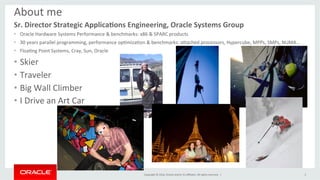








![Copyright © 2016, Oracle and/or its affiliates. All rights reserved. |
OLD
case class Customer (c_custkey: Int, c_name: String,
c_address: String, c_city: String, c_phone: String,
c_mktsegment: String)
...
object RCDBTestProgram {
def main(args: Array[String]) {
val sparkConf = newSparkConf()
.setAppName("RCDB")
val sc = new SparkContext(sparkConf)
val sqlContext =
new org.apache.spark.sql.SQLContext(sc)
...
val dataDir ="file:/Users/bc/datasets/R_SF1000/”
val df1 = sc.textFile(dataDir+”customer.csv")
.map(_.split(";"))
.map(p => Customer(p(0).trim.toInt,p(1),
.trim,p(2).trim,p(3)
.trim,p(4).trim,p(5).trim,p(6).trim))
.toDF()
df1.registerTempTable(”customer”)
...
query = "””SELECT COUNT(*) FROM customer""”
val count = sqlContext.sql(query).take(1)
New
object RCDBTestProgram {
def main(args: Array[String]) {
val sparkSession = SparkSession.builder
.appName("RCDB”).getOrCreate()
...
val dataDir ="file:///Users/bc/datasets/R_SF1000/”
val custSchema = StructType(
StructField("c_custkey", IntegerType, true) ::
StructField("c_name", StringType, true) ::
StructField("c_address", StringType, true) ::
StructField("c_city", StringType, true) ::
StructField("c_phone", StringType, true) ::
StructField("c_mktsegment", StringType, true) :: Nil)
val df3 = sparkSession.read.option("sep", ";")
.option("header","false").schema(custSchema)
.csv(dataDir+"customer.csv").toDF().repartition(256)
df3.createOrReplaceTempView("customer")
df3.persist(StorageLevel.OFF_HEAP)
...
query = "””SELECT COUNT(*) FROM customer""”
val count = sparkSession.sql(query).take(1)
...
sparkSession.sql("SHOW TABLES").show()
sparkSession.catalog.listTables.show()
12
Apache Spark 2.0.0
New SparkSession replacing the SQLContext
https://databricks.com/blog/2016/08/15/how-to-use-sparksession-in-apache-spark-2-0.html](https://image.slidesharecdn.com/spark-perf-meetup-portland-oracle-2016-0818-160823153254/85/Performance-in-Spark-2-0-PDX-Spark-Meetup-8-18-16-12-320.jpg)

![Copyright © 2016, Oracle and/or its affiliates. All rights reserved. |
Apache Spark SQL: Catalyst OpImizes SQL/DSL ExecuIon
14
*HashAggregate(keys=[], funcIons=[count(1)])
+- Exchange SingleParIIon
+- *HashAggregate(keys=[], funcIons=[parIal_count(1)])
+- *Project
+- *Filter ((isnotnull(lo_quanIty#89) && (lo_quanIty#89 >= 10)) && (lo_quanIty#89 <= 20))
+- InMemoryTableScan [lo_quanIty#89], [isnotnull(lo_quanIty#89), (lo_quanIty#89 >= 10), (lo_quanIty#89 <= 20)]
: +- InMemoryRelaIon [lo_orderkey#81, lo_linenumber#82, lo_custkey#83, lo_partkey#84, lo_suppkey#85, lo_orderdate#86,
lo_orderpriority#87, lo_shippriority#88, lo_quanIty#89, lo_extendedprice#90, lo_ordtotalprice#91, lo_discount#92,
lo_revenue#93, lo_supplycost#94, lo_tax#95, lo_commitdate#96, lo_shipmode#97],
false, 16384, StorageLevel(disk, memory, o‚eap, 1 replicas)
: : +- Exchange RoundRobinParIIoning(16)
: : +- *Scan csv [lo_orderkey#81,lo_linenumber#82,lo_custkey#83,lo_partkey#84,lo_suppkey#85,lo_orderdate#86,
lo_orderpriority#87,lo_shippriority#88,lo_quan$ty#89,lo_extendedprice#90,lo_ordtotalprice#91,lo_discount#92,
lo_revenue#93, lo_supplycost#94,lo_tax#95,lo_commitdate#96,lo_shipmode#97] Format: CSV,
InputPaths: file:/Users/bradcarlile/datasets/RCDB_SF1/lineorder-new.csv,
PushedFilters: [],
ReadSchema: struct<lo_orderkey:int,lo_linenumber:int,lo_custkey:int,lo_partkey:int,lo_suppkey:int,lo_orderdat...
Qbet: SELECT count(*)
FROM lineorder
WHERE lo_quanIty BETWEEN 10 and 20
Can look at OpQmized plan with
Explain plan created by using:
sparkSession.sql(query).explain()](https://image.slidesharecdn.com/spark-perf-meetup-portland-oracle-2016-0818-160823153254/85/Performance-in-Spark-2-0-PDX-Spark-Meetup-8-18-16-14-320.jpg)





![Copyright © 2016, Oracle and/or its affiliates. All rights reserved. |
SQL
sqlContext.udf.register("newTitle", Itles.getOrElse((_: String),"Other"))
sqlContext.udf.register("toString", (_: Int).toString)
val avgAge = dataDFRaw.select("Age”).agg(avg("Age")).first().getDouble(0)
val avgFare = dataDFRaw.select("Fare”).agg(avg("Fare")).first().getDouble(0)
query = s"””SELECT
PassengerId,
toString(Survived) AS SurvivedString,
Pclass,
Name,
newTitle(regexp_extract(Name, ".*, (.*?)..*",1)) AS Title,
Sex,
NVL(Age,$avgAge) AS Age,
IF(SibSp + Parch > 3, 1, 0) AS WithFamily,
NVL(Fare,$avgFare) AS Fare,
NVL(Embarked,'S') AS Embarked
FROM dataDFRaw"""
…Same with Scala
def preprocess(data: DataFrame, sqlContext: SQLContext, train: Boolean): DataFrame = {
var dataTrain = data
val avgAge = dataTrain.select(mean("Age")).first()(0).asInstanceOf[Double]
println("avgAge =" + avgAge)
val avgFare = dataTrain.select(mean("Fare")).first()(0).asInstanceOf[Double]
val withFamily = sqlContext.udf.register("withFamily", (sib: Int, par: Int) => {
if (sib + par > 3) 1.0 else0.0})
val fillAge = sqlContext.udf.register("fillAge", (age: Double, Itle: String) => {
var newage = 0.0d
if ((age == avgAge) && (Itle.equals("Master.") || Itle.equals("Miss."))) newage = 14.1 else newage =
age
newage
})
val addChild = sqlContext.udf.register("addChild", (sex: String, age: Double) => {
if (age < 15)
if (sex == "male") "mChild” else "fChild” else sex })
val toDouble = sqlContext.udf.register("toDouble", ((n: Int) => { n.toDouble }))
dataTrain = dataTrain.withColumn("Title", findTitle(dataTrain("Name")))
dataTrain = dataTrain.na.fill(avgAge, Seq("Age"))
dataTrain = dataTrain.withColumn("fixAge",fillAge(dataTrain("Age"),dataTrain("Title")))
dataTrain = dataTrain.withColumn("Pclass",toDouble(dataTrain("Pclass")))
dataTrain = dataTrain.na.fill(avgFare, Seq("Fare"))
dataTrain = dataTrain
.withColumn("withFamily", withFamily(dataTrain("SibSp"), dataTrain("Parch")))
dataTrain.withColumn("sexMod", addChild(dataTrain("Sex"), dataTrain("Age"))) }
20
SelecIng Features & GeneraIng Features
Kaggle Titanic Challenge: SQL & Scala](https://image.slidesharecdn.com/spark-perf-meetup-portland-oracle-2016-0818-160823153254/85/Performance-in-Spark-2-0-PDX-Spark-Meetup-8-18-16-20-320.jpg)


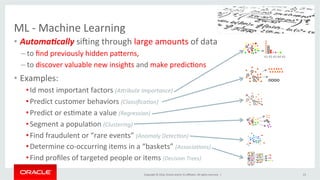



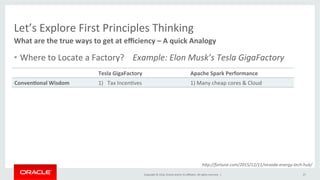






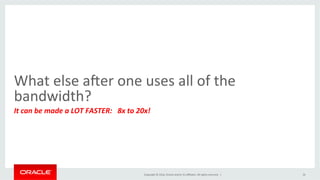













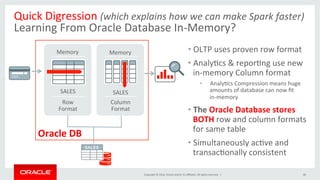














![OOW16 - Oracle E-Business Suite Integration Best Practices [CON6709]](https://cdn.slidesharecdn.com/ss_thumbnails/con6709-oraclee-businesssuiteintegrationbestpractices-160930182601-thumbnail.jpg?width=560&fit=bounds)



![OOW16 - Maintenance Strategies for Oracle E-Business Suite [CON6725]](https://cdn.slidesharecdn.com/ss_thumbnails/con6725-elkephelps-maintenance-strategies-for-oracle-e-business-suite-160930182637-thumbnail.jpg?width=560&fit=bounds)





![OOW16 - Testing Oracle E-Business Suite Best Practices [CON6713]](https://cdn.slidesharecdn.com/ss_thumbnails/con6713-testingoraclee-businesssuitebestpractices-160930182725-thumbnail.jpg?width=560&fit=bounds)


![OOW16 - Personalizing Oracle E-Business Suite: The Next Generation [CON6716]](https://cdn.slidesharecdn.com/ss_thumbnails/con6716-senthilkumarramalingam-personalizing-oracle-ebs-the-next-generation-160930182720-thumbnail.jpg?width=560&fit=bounds)




































































